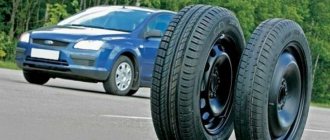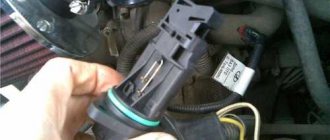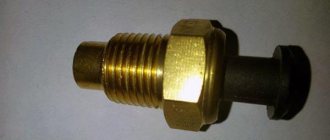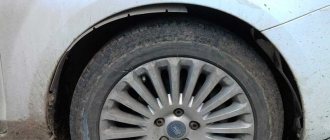Issues related to the life of car tires concern not only car owners, but also manufacturers. There are no technical difficulties in ensuring the long-term preservation of rubber; the issue is rather legal and economic. It is not very profitable to invest in increasing the durability of tires if the terms are limited by law, and competitors are not going to act against their own benefit.
Therefore, the declared life time of tires is approximately the same for all, and experience shows that it is quite consistent with common sense.
What is the expiration date of tires?
The shelf life is considered to be a guaranteed time during which you can expect no surprises from the tires; the manufacturer is confident that the product will meet all its characteristics at any time during this period. And legislative documents and factory standards specify the data.
GOST
According to GOST 4754-97, which regulates the properties of passenger vehicle tire models entering the market, a minimum acceptable shelf life of 5 years is established. That is, manufacturers are obliged to guarantee that if the operating rules are followed, nothing will happen to the tire during this time, and it will fully provide its declared properties.
On the subject: What to do if a wheel is stuck to the hub
This does not mean that after 5 years the tire can be thrown away, but it has the right to partially lose some of its qualities. Despite the experience among motorists and professionals that tires actually last up to 10 years, this is also confirmed by some manufacturers; after the expiration date, the owner of the car will take responsibility for safety.
A tire may noticeably or without visible changes lose many parameters, including those directly affecting safety:
- adhesion properties of the tread rubber mixture with various types of road surfaces;
- cord strength, which is responsible for the correct shape of the tire profile under operating pressure and the wheel’s resistance to impact loads;
- tire tightness, which affects the likelihood of a sudden loss of pressure, which is tantamount to destruction;
- wear rate under severe operating conditions.
Following the recommendations of GOST will help you avoid troubles, or at least significantly reduce their likelihood.
Summer tires
If anyone is sure that rubber will not change its properties much even in 10 years, then this most likely applies specifically to summer tires. They have a obviously more rigid and resistant rubber compound composition, a durable cord with minimal compliance to lateral slips.
But this also has a downside. Summer tires are subject to much harsher use, which is associated with high speeds and temperatures - the two main enemies of road tires. Therefore, you should not rely on the special strength of hard summer tires.
Even the fastest and highest quality tires are recommended to be replaced with new ones after approximately 6 years of operation, without paying attention to the remaining tread depth, which is important, but does not guarantee safety.
Winter
Winter tires are much softer because they work at low temperatures and should not “tan” at the same time. Each winter type, namely friction Velcro and studded tires, guarantees its traction properties with a coating that seems absolutely unsuitable for driving.
The lamellas of friction tires must have flexibility and geometric dimensions that ensure maximum tight contact of the ribs with the ice. This is exactly how a studless winter tire works, and not in the “sticking” way, as one might think from the popular name. It is simply impossible to stick there; the ice in the contact zone melts and the rubber slides.
This is interesting: What to do if in the heat the car does not pull, jerks and stalls
Studded tires must hold the steel studs in their sockets, while allowing them to have a strictly defined freedom. Naturally, if the tread loses its elastic properties, then, as in the case of Velcro, nothing good will happen in terms of traction with ice, snow or even cold asphalt.
The manufacturer knows this, so strict measures are taken to ensure long-term stability of the rubber properties.
The tire will serve its 5 years, but you need to know that at the end of the term it will already be a tire with very mediocre contact with the winter road. An owner who cares about safety will simply replace it after no more than three seasons. This is indirectly supported by manufacturers who update their winter tire model lines with approximately the same frequency.
Tread depth
Driving a car whose tires have a residual tread depth less than the required values is punishable by a fine. Police rarely pay attention to this, but it is worth bearing in mind the administrative responsibility. Thus, according to Part 5 of Article 590 of the Code of Administrative Offenses of the Republic of Kazakhstan, the treasury will have to pay 5 MCI, or 13,890 tenge in 2020. Repeated violation within a year increases the penalty to 20 MCI (55,560 tenge).
The minimum remaining tread depth is specified in paragraphs 5.6.1 and 5.6.2 of Appendix No. 7 TR CU 018/2011 “On the safety of wheeled vehicles”. The text states that for passenger cars the residual must be at least 1.6 mm for summer tires and at least 4 mm for winter tires and those marked with the signs: M+S, M&S and M S.
Note that measuring the tread depth with a ruler is an extreme step. Almost all modern tires have special wear indicators. As soon as they appear, the tires should be replaced.
How long can tires be stored without use?
When storing tires, even perfectly correctly, they cannot get any younger. Contact with atmospheric oxygen, slow reactions in rubber, plastic and metal, occurs constantly, so storage is included in the guaranteed shelf life.
Buying a tire that has been stored for these five years is too optimistic. Although even at the end of the term the wheel will remain completely safe and meet the manufacturer’s requirements.
But technically, within a year the tire will be theoretically unsuitable. And here a lot depends on information that cannot be accessed.
No one will say how the tires were stored, how carefully all recommendations were followed. Especially if it's winter tires. You definitely can’t buy it after long storage.
Tire marking
This is complete information about tires in one place. It is standard; dimensions, technological characteristics, and features are indicated on the side.
What to look for when purchasing
When purchasing, you need to look at the following characteristics:
Is the type and size suitable for a particular car? These specs look like 195/65R15, where:
- 195 – profile width in millimeters;
- 65 – percentage ratio of profile height and width;
- R – radial cord;
- 15 – disk diameter in inches.
You can learn about the needs of a specific machine from technical documents.
- Speed and load. For example, 98W means: 98 – load per wheel (kg). W – maximum speed (km/h). Decodings are indicated in special tables common to the whole world.
- Brand, date of manufacture. After the manufacturer's letter designation there are four numbers - this is the week and year of manufacture.
- Seasonality. The summer one is marked with the image of the sun, the winter one – with snowflakes.
How to identify expired tires
You need to find the production date and add 5 years to it. You also need to stock up on measuring instruments and assess the degree of tread wear. The residual height of 2-3 mm will be critical for summer, and 4-6 mm for winter.
Factors affecting tire performance
The service life can be extended by moderate use:
- the lower the speed, the longer the tire will last;
- the same can be said about temperature;
- At least once a year it is necessary to check the wheel alignment angles;
- pressure should be strictly maintained according to the instructions and monitored weekly;
- It is worth changing wheels only if the driver is sure why this is necessary, and not just because the instructions say so;
- the tire must be balanced, even if its vibration is unnoticeable;
- Sharp braking and acceleration affect the life of a wheel even worse than speed and temperature, just like extreme cornering.
You should not leave your car in the open sun, this is harmful not only to the body, but also to the tires.
Tire service life - what to consider
When determining the service life of winter tires, the time when operation is possible and safe is taken into account, taking into account the requirements of traffic regulations and the manufacturer’s recommendations.
In most cases, the manufacturer stipulates the physical suitability of the product, or legally this indicator is taken equal to 10 years. The practice of using winter tires shows that the established deadlines do not always coincide with reality. For winter tires from various manufacturers, according to reviews in Russia, the average service life is:
- European manufacturers. The mileage, taking into account different models, is in the range of 50-60 thousand km.
- Russian manufacturers. Many models are licensed, or our own developments, the quality of which has improved. The mileage ranges from 40 thousand km and above.
- Tires from China. On average, with average functional characteristics, tires exhibit good wear resistance. There are known cases of mileage on one set of up to 80 thousand kilometers.
Car owners at the stage of choosing a set of wheels - studded tires or Velcro, should take into account that the duration of use does not exceed several seasons or 30 thousand km. This is due to increased wear of the protruding elements.
How to identify expired tires
According to the standard, the tire production date is indicated in an oval casting on the sidewall and consists of 4 digits. The first two indicate the week of the year, the second two indicate the last digits of the year of manufacture. It’s not difficult to count how much is left until the guaranteed expiration date. Everyone can decide for themselves whether they are ready to take a product that has been lying around for 5 years, or whether they can go to the next store and buy new tires. A good discount might be worth it.
Why does rubber deteriorate during storage?
During storage, rubber deteriorates if certain conditions are violated:
- orientation of tires when stacking them on warehouse shelves;
- minimum and maximum temperature;
- air humidity;
- illumination, especially in the UV range;
- temperature changes;
- presence of chemicals in the air.
Specific data for each item is provided in the technical documentation of the tires. But even without this, it is known how storage facilities for automobile tires should be equipped. What matters is how much the supplier follows the rules.
Tire release date - is it worth looking for the “freshest” ones?
In recent years, we have noticed that demanding customers have increasingly become interested in the year of manufacture of the wheels they purchase. Is this parameter really that important?
We are forced to note that many customers often do not understand why they need the freshest tires, because we are not talking about hot cakes. There is a lot of contradictory and unfounded information on this matter on the Internet, so to try to understand this issue we use the most objective and authoritative expert opinion from Michelin.
TIRES ARE NOT BANANAS!
Apparently, even this leading corporation could not help but react to the growing problem, and the Philippine division launched a special explanatory campaign “Tires are not bananas!” People are afraid that tires become old over time. Three independent studies conducted in South Korea, Germany and Saudi Arabia prove that under storage conditions of +40 degrees Celsius for 20 years, the condition of tires will be similar to a mileage of 40,000 km. A year of active operation is approximately equal to ten years of storage in a warehouse.
Numerous tests have revealed that when tires are stored for three years, there is virtually no difference from newly produced ones. Braking, acceleration and rearrangement on conditionally “old” tires are identical to conditionally “new” ones, and the service life and impact resistance are also no different. So calling all the stores in the city in search of “fresh” is pointless.
By the way, the domestic GOST also says unequivocally - within five years from the date of production, tires can be safely sold. With proper storage, the wheels do not lose their properties for more than five years, because they are resistant to temperature changes.
But in the pursuit of the “freshest” tires, many buyers miss the fact that it is much more important for their well-being of the tires, their service life, and trouble-free driving to monitor the pressure, uniform wear, and avoid overloads during operation. After all, even a seemingly insignificant deviation of 0.3 atm. in one direction or another can reduce the tire service life by a quarter, and overload can even lead to fatal damage to the cord or liner.
Another point that some tire store customers do not take into account: tires are pre-produced at the manufacturer's factory. For example, in the spring of 2022, you ask the store salesperson to pick up tires with a production date of 2022. But the production of the summer assortment begins in the fall of 2017, and the required standard size for the desired year may not be in stock at all!
MICHELIN ADVICES:
1) Our conclusions and recommendations are consistent with Michelin’s advice - try to avoid using tires older than 10 years. It's already time.
2) During operation, pay more attention to the condition of the wheels, damage, and pressure, which should correspond to the recommended values.
3) Keep in mind: three-year-old tires, in terms of performance characteristics, are virtually identical to those produced quite recently. And let’s add on our own: in our experience, the stud holds better in studded wheels that have been in storage for a couple of years. The reason for this is that diffusion, although it does not reach noticeable values, is objectively possible to lose spines and is noticeably reduced. As such, research on this topic has hardly been conducted, but practice shows that this is exactly the case.
When tires should not be used
Tire condition is an essential safety element. Therefore, they must definitely be replaced with new ones if:
- the tread depth does not comply with the regulations, it is different for all types of tires;
- the expiration date has been significantly exceeded, the tire is more than 10 years old;
- there are deep cuts, the cord or breaker is damaged;
- the tire was subject to uneven wear;
- the rubber began to crack due to age and harsh use;
- the tire does not hold pressure even on a new rim;
- the wheel is poorly balanced.
A specialist can determine the condition of the tire more accurately. Experienced tire service employees have a lot of practical information.
Standards and recommendations of tire manufacturers
Measuring the depth of the tread layer.
Tires not only wear out during vehicle operation, they are also subject to natural aging. These products must be replaced if their service life is exceeded. The fact is that tires are made from a rubber compound, which ages over time and loses its elasticity and resilience. The use of such tires is unsafe: the car may become uncontrollable, plus the tire may rupture while driving.
According to domestic standards, the service life of tires is 5 years from the date of their manufacture; these standards are regulated by GOST 4754-97 and 5513-97. In Western countries, the service life of tires reaches 10 years. Legislatively, neither in Russia nor in the West there are acts obliging motorists to replace tires after the end of their warranty period. But for the sake of your own safety and driving comfort, such products should be replaced.
Manufacturers indicate the shelf life of tires, it is 3 years; according to the recommendations of the manufacturers, tires that have been stored for more than this period cannot be considered new. If the rules for storing tires are not followed, they are destroyed, the tire begins to crack, may dry out, lose elasticity, and so on. Its use is unsafe, even if the tire is less than 3 years old.
You can find out how old a tire is by looking at the corresponding marking on its side.
We recommend watching a video about the signs indicating the end of the service life of tires:
How to extend the life of car tires
Tires cannot be considered a perishable product, delicate and needing to be stored away from roads and cars. These are durable, resistant and high-tech products designed to withstand many hardships of road service. And there is only one condition for them to fully utilize their considerable resource - to follow the operating rules.
Some of them are outlined above, the rest are taught in driving schools. There are no secret techniques or nuances here. Pressure, speed, temperature, rough driving on bad roads - the effect of such driving on tires is known to everyone. We can only add the provision of seasonal storage conditions.
Changing summer tires to winter tires and vice versa has become mandatory. If there is no confidence and conditions that you can independently ensure the above requirements for storing tires, then it is better to use the services of emerging warehouse organizations, where, for a small fee, seasonal tires will wait their turn in compliance with all scientific and technical rules.











